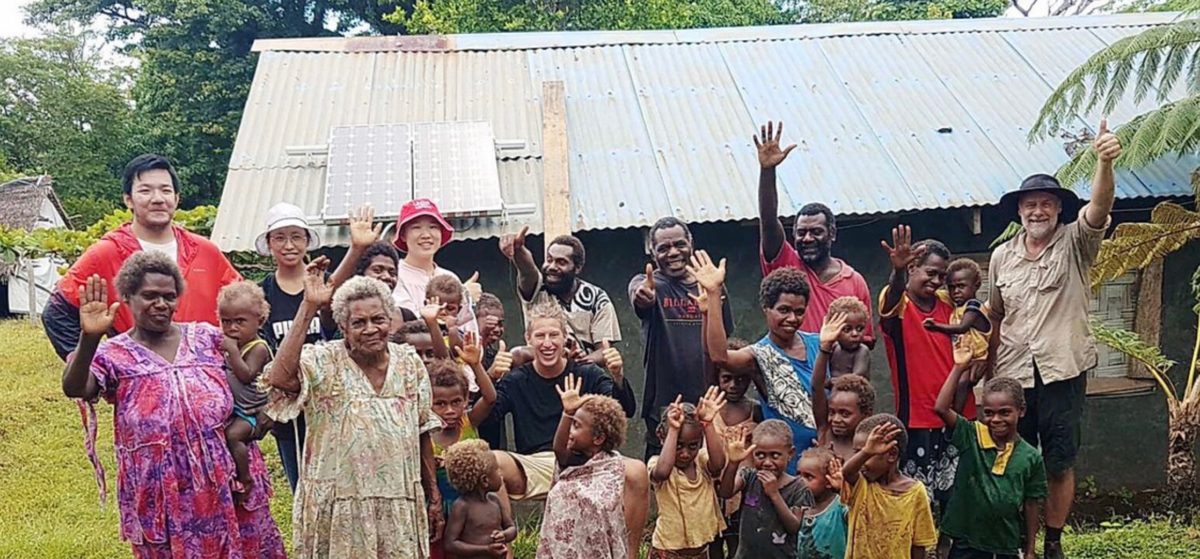The University of New South Wales (UNSW) Students’ Vanuatu Solar Energy Project, or UNSW Énergie Renouvelable Vanuatu (UNSWERV), is a team of UNSW students, staff and volunteers who set out to improve communications and lighting needs for health and education in remote areas using solar PV.
In January this year, the team worked on all manner of projects. The first task was to shift the Imaki village mini-grid from hydropower, which had been destroyed by Cyclone Pam in 2015, to solar power. Since Cyclone Pam tore through the region, Imaki has been using an expensive interim diesel power source. Van
The doubly troubling aspect of the effects of natural disasters like Cyclone Pam upon remote areas is that often the very tools needed in the aftermath, such as for ease of communication, running water, and artificial lighting, would’ve been undone by the storm itself.
Thankfully, the solar PV industry is improving its cyclone resistance standards, after all, self-sufficient stand-alone technology like solar PV is already far more secure than an electricity source dependant on transmission wires and the like. Only last month Solarwatt’s Vision glass-glass PV successfully passed cyclone-testing in Darwin.
With natural disasters likely to increase in number and magnitude as a result of Climate Change, the improving durability of solar PV becomes ever more important. Self-sustaining sources of electricity, such as solar-powered microgrids, give disaster-struck communities a better chance of survival and recovery.
At the Loanatom village on the West side of the island, the team aided the community to convert their bore pump to solar. Now, with the rise of the sun, the water begins to run.
UNSWERV has been coming to Tanna Island since 2007/2008, meaning that the teams have built community connections but also that UNSWERV has quite a lot of repair work to do when they visit. The UNSWERV team did just that at the Malaria Laboratory at the Green Hill dispensary on the island’s North side, and to the Nepraintata Area around the base of Mt Yasur volcano. It was under the volcano that the team was able to participate in a linking ceremony with members of the Nepraintata Area Council.
“I felt great when I lit the bulb by myself and I was deeply moved by the enthusiasm of the local people,” said Yiyang Gao, a participating student. “I hope more students can participate in this project and make contributions to the local community.”
Of course, this is not the only sustainable energy program UNSW is engaged in with our Pacific neighbours. UNSW Engineering’s Sustainable Energy for Developing Countries was challenged in December 2019 to design a solar system that is technically and financially sustainable for remote villages in Fiji and came up with some innovative solutions.
UNSWERV is generously supported by UNSW School of Photovoltaic and Renewable Energy Engineering, SMA Australia, 5B Australia, Alpha ESS Australia and the UNSW Institute for Global Development, among many others. However, the level of sustainability UNSWERV can supply is directly proportional to funding, and more funds for batteries, mounting frames, cables, connectors, shipping and transport would promote UNSWERV and the communities they work in to new levels of sustainability.
To donate and help support the project, see here.
This content is protected by copyright and may not be reused. If you want to cooperate with us and would like to reuse some of our content, please contact: editors@pv-magazine.com.









I’m from Tanna .
And my name is Jackson Iakapas
I’m working with the UNSW students for more than 5 years ( sola pv engineering)
17 aidpost
7 schools
And had help many locals repaired even train the locals to install their own systems.
UNSW has done their best to offer Tanna that never happen in history.
I never stop expressing my heart and saying thank you to the students and the Tanna famous professer Richard .
The chiefs council at Neprainetata are proud to say thank you very much)(tanak asori) for making the health center in our area another step to develop in solar lightning at night.
The ceremony had performed at the Neprainetata is a joining bridge from Tanna to (UNSW) AUSTRALIA As a whole to exchange .
Tanna and the people of Neprainetata want to say there are many places especially shools community water pumps and view more aidpost that need help from you.
Tanna will still be your home and and friend.